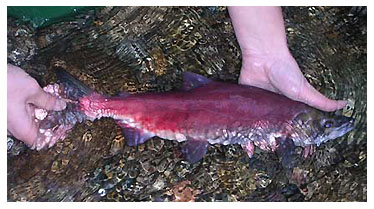The geocache is not at the posted coordinates, although it's a good place to park. Read the page to figure out the correct coordinates to find the cache.
The Issaquah Salmon Hatchery is a fun place to visit, with lots of exhibits and activities, many designed for kids. It's the most popular of the Washington Department of Fish and Wildlife (WDFW) hatcheries, with thousands of visitors each year. The Hatchery raises fish for release and promotes watershed stewardship, teaching visitors about salmon, their habitat, and the Lake Sammamish watershed.

The Hatchery is best known for its work with chinook and coho salmon – 1.7 million chinook smolts were released in Spring 2015 – but it also partners with the Lake Sammamish Kokanee Work Group to help ensure survival of the kokanee salmon. Today, the kokanee is found only in the Lake Sammamish watershed, but its habitat once encompassed the lower Cedar River, smaller tributaries to Lake Washington, and the Sammamish River.
Lack of suitable spawning areas are a major limiting factor, so to help keep the Lake Sammamish kokanee from going extinct, each fall since 2009, WDFW biologists have collected adult kokanee from three local streams and artificially spawned them at the hatchery. Once the eggs hatch in the spring, the fry are released to make their way to Lake Sammamish, where they mature into adult kokanee and hopefully return to their native creeks to spawn.
To determine the correct cache coordinates, answer the questions below. One answer you can find online, and the other requires you to visit the Hatchery exhibits. Match the correct North coordinates with the correct West ones to get the complete final coordinates.
Before You Go:
Both the Snoqualmie and Muckleshoot Indian tribes work with the Hatchery. Why were Lake Sammamish kokanee historically an important food source for Snoqualmie tribal people?
Reference link
A. They were the easiest fish to catch = N 47° 31.766
B. There were more kokanee than any other type of fish = N 47° 31.695
C. They returned to spawn when other food sources were scarce = N 47° 31.742
D. They were quick to cook = N 47° 31.723
At the Hatchery: Fish Species (Stage 1: N 47° 31.786 W 122 02.351)

WDFW hatcheries currently raise 16 different species of fish, from sockeye salmon to rainbow trout. The kokanee salmon
(Onchorhynchus nerka) is smaller than its cousins, typically measuring 12 to 14 inches. The kokanee is actually a type of __________ salmon that remains in fresh water its entire life.
A. Chinook = W 122° 02.411
B. Chum = W 122° 02.299
C. Coho = W 122° 02.348
D. Sockeye = W 122° 02.368

This cache was placed with the permission and support of FISH (Friends of the Issaquah Salmon Hatchery).


Unlike other salmon, the Lake Sammamish kokanee salmon lives its entire life in fresh water. Kokanee spawn in tributary creeks, and their offspring migrate to the lake as they mature, then return to their home creeks as adults to spawn the next generation.
Historically, the kokanee filled a critical ecological role within the Lake Sammamish watershed and was an important food and cultural resource for local tribes. But this "little red fish" has experienced a dramatic decline, leading to near-extinction in recent years.
To address the kokanee's plight, citizens, landowners, nonprofit agencies, and local, state, tribal, and federal governments have united to restore native kokanee salmon populations and the ecological integrity of the greater Lake Sammamish basin. In 2013, this group received an Urban Wildlife Refuge Partnership (UWRP) designation from the U.S. Fish and Wildlife Service, one of the first in the country.
The Kokanee Quest was sponsored by the Lake Sammamish UWRP, a consortium led by the King County Department of Natural Resources and Parks (KC DNRP) and the U.S. Fish and Wildlife Service (USFWS).


